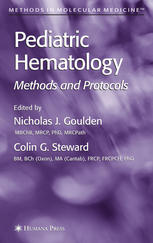

Most ebook files are in PDF format, so you can easily read them using various software such as Foxit Reader or directly on the Google Chrome browser.
Some ebook files are released by publishers in other formats such as .awz, .mobi, .epub, .fb2, etc. You may need to install specific software to read these formats on mobile/PC, such as Calibre.
Please read the tutorial at this link: https://ebookbell.com/faq
We offer FREE conversion to the popular formats you request; however, this may take some time. Therefore, right after payment, please email us, and we will try to provide the service as quickly as possible.
For some exceptional file formats or broken links (if any), please refrain from opening any disputes. Instead, email us first, and we will try to assist within a maximum of 6 hours.
EbookBell Team

5.0
98 reviewsMolecular techniques are now an integral part of the practice of modern pediatric hematology. In Pediatric Hematology: Methods and Protocols, hands-on masters of laboratory techniques describe their best methods for investigating and detecting a wide variety of hematological disorders. Here, the reader will find cutting-edge molecular protocols for the diagnosis of Fanconi anemia, dyskeratosis congenita, immunodeficiency, and most forms of hemoglobinopathy. In addition, there are detailed methods for molecular human platelet antigen genotyping, an effective PCR procedure for thrombophilia screening, and protocols for fluorescent in situ hybridization for cases in which insufficient metaphases are recovered or cryptic translocations are not visible. Since the measurement of minimal residual disease (MRD) provides a much more accurate risk-directed therapy, three methods are presented for detecting residual leukemia below the threshold of light microscopy, along with relatively simple, rapid, and inexpensive methods for the detection of MRD in ALL and AML. On the cutting-edge of technology, microarrays are used for the analysis of gene expression in childhood leukemia, and novel methods of graft engineering and reduced intensity conditioning regimens are applied to tissue typing for the assessment of donor/recipient chimerism. Each readily reproducible protocol is described in step-by-step detail and includes an introduction to the principle behind the method, equipment and reagent lists, and tips on troubleshooting and avoiding known pitfalls.
Cutting-edge and highly practical, Pediatric Hematology: Methods and Protocols offers experimental and clinical investigators a gold-standard collection of reliable molecular techniques essential to the diagnosis, classification, and treatment of childhood hematological disorders.